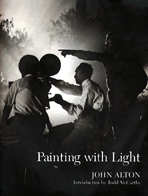
|
|
Nov. 12, 1996 (c)
|
Column Index - Nov. 12, 1996
|
|
![]()

"Painting with Light" cover
Martin's Film Noir Page
Internet Movie Database / Film Noir
An American in Paris
Hollywood Online
|
The Light and Darkness of the Film Noir
Depicting with light It is a well-known fact that a film is created out of light, but compared to sound, which has been incorporated with the invention of the talkie, it has been receiving relatively little attention. The reason for that can be imagined easily. With sound, as the words such as "text", "sound effect", and "background music" indicate, it is easy to relate it with the "meaning" of the film lying in the background. In this case, what is forgotten is the "particle" of sound referred to by Roland Barthes, thus, for light, which is also composed of "particles", an equal degree of interest as Barthes's "sound" or "ecriture" must be appropriated. "Painting with Light" published last year from the University of California is a reprint of the same title published in 1949. One of the editors of "Kings of the B's", Todd McCarthy, writes a comment that reflects his deep attachment to the book. The writer is John Alton. As McCarthy also writes, if one remembers this name, Alton, which was only referred to together with the films of Anthony Mann, he would be quite an expert on Film Noir. However, if we mention that he was the cinematographer who won the Academy Award with "An American in Paris", there are probably many who can remember fragments from the movie. As the title indicates, the book explains cinematography as the technique using light, but what is superior about this book compared to many other similar types of books, is that the writer explains cinematography in Hollywood in very specific terms, pointing out the positions of the staff and equipments, and how the writer deals with light, based on his own creative experiences, which are systematically recounted. When explained like this, the book may sound like merely a good manual. If this were a book which only took up "technology" of 50 years ago, there is no need for anyone, who does not have the intention of studying, to read it. Then, what is so attractive about this book? The attractive points about "Painting with Light" The appeal of this book lies in the fact that it allows us to understand that learning is always an event which is born at the vanguard, or a discovery of a new relationship by the hand which deals with materials, and that it is not found in the vast amount of technology accumulated in the "factory" called Hollywood, or in the goal of learning and communicating in order to justify that technology. For a film, which can be shot simply as long as a camera is rolled, unexpectedly, or rather, naturally, similar to the material resistance felt when the brush meets the canvas, a way of contacting with light, which is filled with hesitation and decisiveness, is necessary. Therefore, if the distance between the camera and the physical body seems to feel farther than the distance between the brush and the hand, that indicates a problem of sensibility towards the film. For example, referring to a comment by Alton concerning the cinematography of a raining scene, he says the following. "For those who wish to economize, the poor man's rain effect can be produced with just the water in front of the lens covering the entire picture, and in the background some people walking around with shiny umbrellas." The playfulness of light reflected on the surface of the wet umbrella naturally has nothing to do with the "meaning" of the movie, but that alone creates a sufficient reason why people demand rain in a film, and why the writer becomes our "beloved (Alton)". New "waves" constantly roll in Although it may not sound so "glorious", the fact that there was a person interested in the "poor man's" cinematography, earlier than the Nouvelle Vague, and that moreover, he was a cinematographer of the first class, is quite interesting. Shooting a film can be described as a repetition of learning to demand what is unexpected, but in Hollywood, such an attitude soon changed into a system of customs carrying solidified meanings in return forglory. Reading the comments written by McCarthy, one can see how difficult that situation had become. The details of "rediscovering" Alton, whose history can be described with pride as "Romanesque", can be obtained by reading McCarthy's moving commentary. Alton was trained under Ernst Rubich, built the Argentine film industry of the '30's almost on his own, established the cinematography of FIlm Noir, strongly supported the early works of Anthony Mann in B movies shot in short periods and at low budget, and was the favorite cameraman of Vincente Minnelli, and his masterpiece is certainly Joseph Louis's "The Big Combo" (1955, Hollywood Attic, Burbank, California). This film, which pursues to the extreme, the light and darkness as materials, cannot be seen on screen in Japan today, but is available in the form of video. [Yuzo MORITA/Film Critic]
|
|
|
|
|
|
|
|
|
|
|
Nov. 12, 1996 (c)
|
[home]/[Art information]/[Art Watch]
Copyright (c) Dai Nippon Printing Co., Ltd. 1996
Network Museum & Magazine Project / nmp@nt.cio.dnp.co.jp
